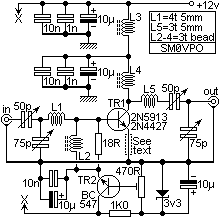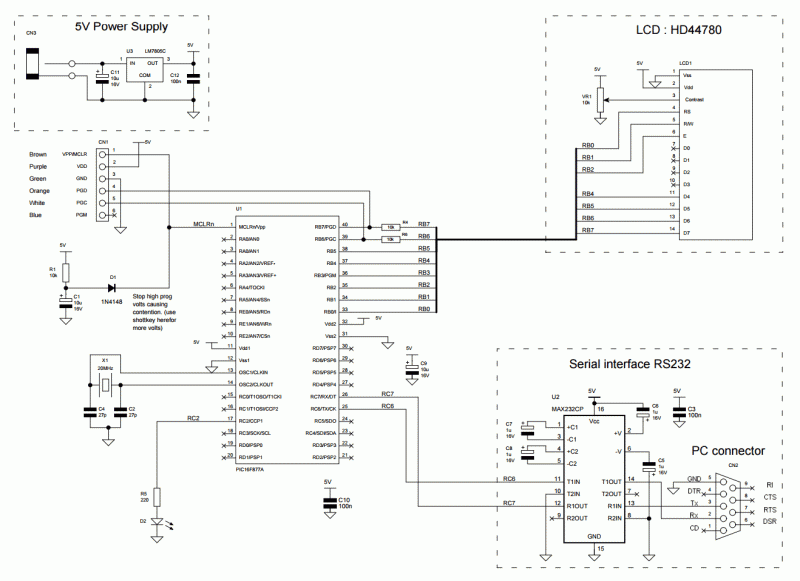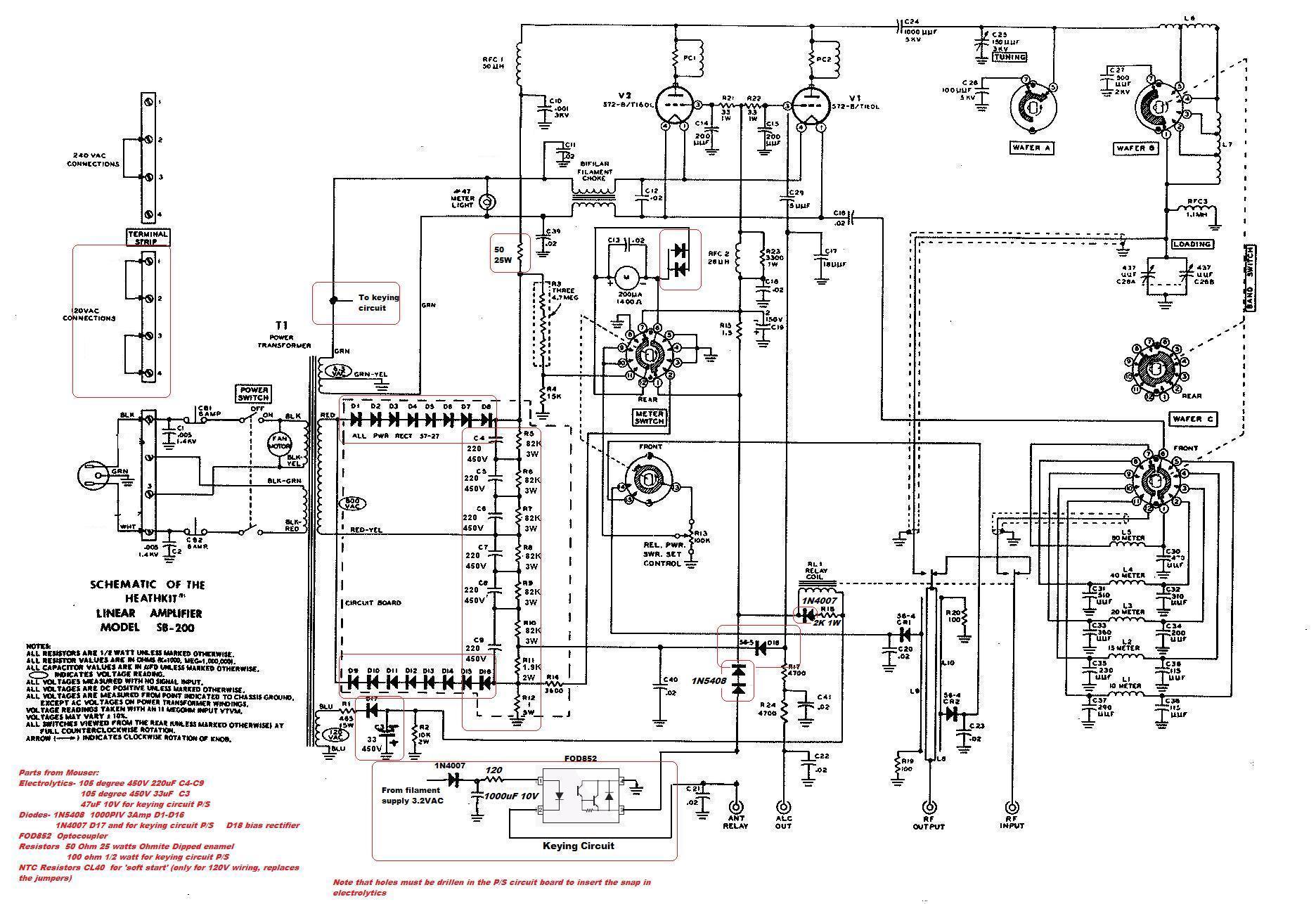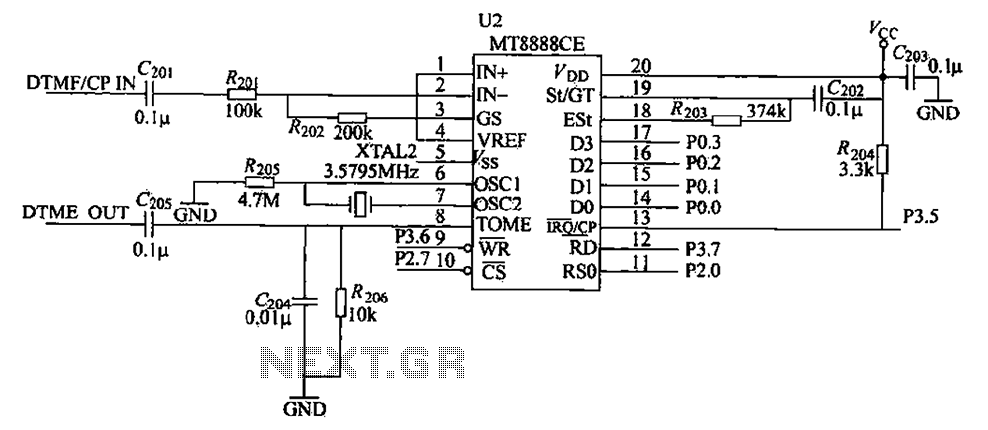
880MHz low-noise amplifier application circuit composed of RF2347
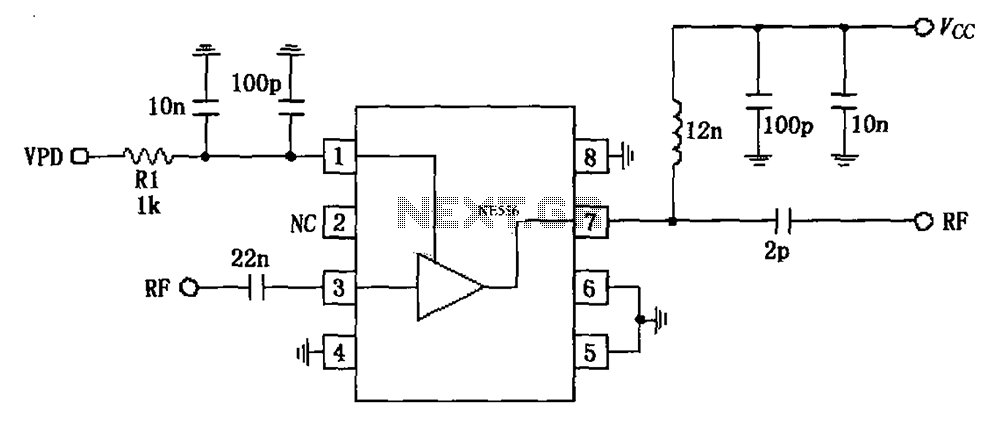
The circuit is based on an 880 MHz RF2347 low noise amplifier application. The radio frequency (RF) signal enters through input pin 3, and after amplification, the output is available at pin 7. The amplifier is directly coupled to pin 3, with an additional 22 pF blocking coupling capacitance. Impedance matching is designed for operation at 836 MHz with a typical impedance of 50 ohms. Pin 7 serves as an open collector output terminal, which can be connected to the power supply (Vcc) through a choke or matching inductor. The output impedance matching network is external and ensures maximum output power and efficiency. Pin 1 functions as the power down control terminal for bias management. When VPD is set to 2.8 V (±0.1 V), the typical current (IPD) is 8.5 mA; when VPD is at 0.9 V, the circuit shuts down. An additional RF bypass circuit is required for proper operation.
The RF2347 low noise amplifier circuit operates effectively at a frequency of 880 MHz, making it suitable for various RF applications. The design incorporates a direct coupling mechanism from the input pin (pin 3) to the amplifier, allowing for minimal signal degradation. The use of a 22 pF blocking capacitor ensures that DC components do not interfere with the RF signal, thereby preserving the integrity of the amplified output.
The output stage, located at pin 7, is configured as an open collector, enabling flexibility in connecting to different power supply configurations through a choke or matching inductor. This design choice allows for efficient impedance matching, which is critical for maximizing output power and overall circuit efficiency. The external output matching network is crucial in aligning the amplifier's output impedance to the standard 50 ohms, facilitating optimal power transfer to subsequent stages or antennas.
Pin 1 serves a dual purpose as the power down control terminal, providing a means to manage the biasing of the amplifier. The circuit is designed to operate at a nominal voltage of 2.8 V, drawing a typical current of 8.5 mA, which indicates the active state of the amplifier. Conversely, when the voltage at VPD drops to 0.9 V, the amplifier enters a low-power state, effectively shutting down to conserve energy. An additional RF bypass circuit is recommended to stabilize the operation of the amplifier during transitions between active and inactive states, ensuring reliable performance across varying conditions. Overall, this low noise amplifier design is well-suited for applications requiring high gain and low noise performance in the RF spectrum. As shown in FIG constituted by 880MHz RF2347 low noise amplifier application circuit. Radio frequency (RF) signal from the input pin 3, after the output of the amplifier 7 feet . 3 feet and the internal amplifier is directly coupled, so 3 feet plus a 22pF blocking coupling capacitance, impedance matching at 836MHz work as 50. 7 feet for the open collector output terminal can be connected to the power supply Vcc through choke or matching inductor, the pin impedance matching is typically 50, external output matching network allows the amplifier output impedance matching for maximum output power and efficiency.
1 foot for the power down control terminal for controlling bias. When VPD (2.8 0.1) V when (IPD is typically 8.5mA) circuit; when VPD 0.9V circuit closes; VPD requested additional RF bypass circuit.
The RF2347 low noise amplifier circuit operates effectively at a frequency of 880 MHz, making it suitable for various RF applications. The design incorporates a direct coupling mechanism from the input pin (pin 3) to the amplifier, allowing for minimal signal degradation. The use of a 22 pF blocking capacitor ensures that DC components do not interfere with the RF signal, thereby preserving the integrity of the amplified output.
The output stage, located at pin 7, is configured as an open collector, enabling flexibility in connecting to different power supply configurations through a choke or matching inductor. This design choice allows for efficient impedance matching, which is critical for maximizing output power and overall circuit efficiency. The external output matching network is crucial in aligning the amplifier's output impedance to the standard 50 ohms, facilitating optimal power transfer to subsequent stages or antennas.
Pin 1 serves a dual purpose as the power down control terminal, providing a means to manage the biasing of the amplifier. The circuit is designed to operate at a nominal voltage of 2.8 V, drawing a typical current of 8.5 mA, which indicates the active state of the amplifier. Conversely, when the voltage at VPD drops to 0.9 V, the amplifier enters a low-power state, effectively shutting down to conserve energy. An additional RF bypass circuit is recommended to stabilize the operation of the amplifier during transitions between active and inactive states, ensuring reliable performance across varying conditions. Overall, this low noise amplifier design is well-suited for applications requiring high gain and low noise performance in the RF spectrum. As shown in FIG constituted by 880MHz RF2347 low noise amplifier application circuit. Radio frequency (RF) signal from the input pin 3, after the output of the amplifier 7 feet . 3 feet and the internal amplifier is directly coupled, so 3 feet plus a 22pF blocking coupling capacitance, impedance matching at 836MHz work as 50. 7 feet for the open collector output terminal can be connected to the power supply Vcc through choke or matching inductor, the pin impedance matching is typically 50, external output matching network allows the amplifier output impedance matching for maximum output power and efficiency.
1 foot for the power down control terminal for controlling bias. When VPD (2.8 0.1) V when (IPD is typically 8.5mA) circuit; when VPD 0.9V circuit closes; VPD requested additional RF bypass circuit.


